Choosing a TV for yourself, your beloved, from the perspective of science, not advertising

Hello.
To write this small article I pushed the dispute regarding the choice of TV.
Now in this area - just like in “megapixels for cameras” - marketing orgy reigns in pursuit of resolutions: HD Ready has long been replaced by Full HD, and 4K and even 8K are becoming increasingly popular.
')
Let's figure it out - what do we really need?
And the school geometry course and some basic knowledge from Wikipedia will help us in this.
So, according to this very Wikipedia , the naked eye of an average person is a unique device that can simultaneously view the space at an angle of 130 ° -160 ° and also distinguish elements at an angle of 1-2 ′ (about 0.02 ° —0.03 °) . In this case, fast focusing occurs at a distance of 10 cm (young people) - 50 cm (most people 50 years old and older) to infinity .
It looks cool. In fact, not everything is so simple.
Below is the field of view of the right eye of a person (perimetric card, the numbers on the scale are angular degrees).

Orange spot - the place of projection of the blind spot of the fundus. The field of view of the eye does not have the shape of a regular circle, due to the restriction of the gaze with the nose from the medial side and the eyelids above and below.
If we impose a picture of the right and left eye, we get something like this:

Unfortunately, the human eye does not provide the same quality of vision throughout the plane in a wide angle. Yes, with two eyes we can recognize objects in the coverage of 180 ° in front of us, but we can recognize them in 3D only within 110 ° (to the green zone), and full-color ones in an even smaller range of about 60 ° -70 ° (to the blue zone). Yes, in some birds the field of view reaches almost 360 °, but we have what we have.
Thus, we get that a person gets the highest quality image at an angle of view of about 60 ° -70 ° . If more coverage is needed - we are forced to “run” with our eyes in the image.
Now - about TVs. By default, we consider TVs with the most popular ratio of width to height as 16: 9, as well as a flat screen.
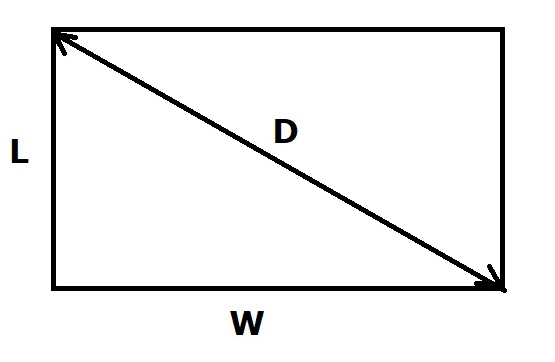
That is, we get that W: L = 16: 9, and D - is the diagonal of the screen.
Hence, recalling the Pythagorean Theorem:

So, taking that permission:
- HD Ready there is 1280x720 pixels
- Full HD has 1920x1080 pixels
- Ultra HD 4K is 3840x2160 pixels,
we get that the pixel side is:
- HD Ready: D / 1468.60
- Full HD: D / 2202.91
- Ultra HD 4K: D / 4405,81
Calculation of these values can be found here.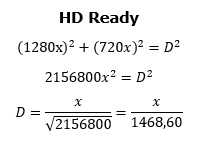
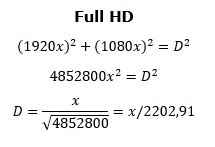
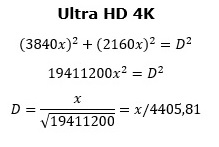



Now we calculate the optimal distance to the screen so that the eye covers the entire image.
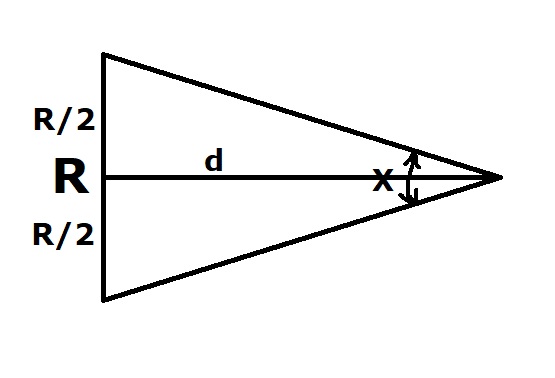
From the figure it is clear that

Since from the height and width of the picture we have a large parameter, the width is - and the eye needs to cover the entire screen to the full width - we calculate the optimal distance to the screen, taking into account that, as shown above, the angle of view should not exceed 70 degrees:

That is: in order for the eye to cover the entire screen in width, we must be at a distance no closer than about half the screen diagonal . At the same time, this distance should be at least 50 cm in order to provide a comfortable focus for people of any age. Remember this.
Now calculate the distance at which a person will distinguish the pixels on the screen. This is the same triangle with the tangent of the angle, only R in this case is the pixel size:
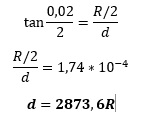
That is: with a distance greater than 2873.6 pixel size, the eye will not see the grain. So, taking into account the calculation of the pixel side above, you need to be at the following minimum distance from the screen in order for the picture to be normal:
- HD Ready: D / 1468.60 x 2873.6 = 1.96D, that is, two screen diagonals
- Full HD: D / 2202.91 x 2873.6 = 1.3D, that is, about a little less than one and a half diagonals of the screen
- Ultra HD 4K: D / 4405.81 x 2873.6 = 0.65D, that is, a little more than half of the screen diagonal
And now what it was all about -
findings
- Do not sit closer than 50 cm to the screen - the eye can not normally focus on the image.
- You should not sit closer than 0,63 screen diagonal - the eye will be tired, because he will have to run around the picture.
- If you plan to watch TV at a distance greater than two screen diagonals - do not buy something steeper than HD Ready - you will not notice the difference.
- If you plan to watch TV at a distance of more than one and a half diagonal screen - do not buy something steeper than Full HD - you will not notice the difference.
- Using 4K is advisable only if you look at the screen at a distance of less than one and a half diagonals, but more than half of the diagonal. Probably these are some kind of computer gaming monitors or giant panels, well, or an armchair, standing right next to the TV.
- Using a higher resolution does not make sense - you either will not see the difference with 4K, or you will be too close to the screen and the angle of view will not cover the whole plane (see p.2 above). The problem can be partially solved with a curved screen - but the calculation (more complicated) shows that this gain is extremely doubtful.
And now I recommend to measure your room, the location of your favorite sofa, the diagonal of the TV and think: is there any point in paying more?
PS I deliberately did not discuss and did not mention characteristics that are difficult for me to calculate and compare.
And their mass: processing frequency, contrast, time for changing the state of a pixel, and so on - here I can get confused even in terminology. They are very important when choosing, but this is a separate topic.
I am discussing only the resolution here and by simple calculation I show that it is particularly large and is not needed ...
It is very possible that with other characteristics - the same marketing pitfalls associated with a lack of knowledge, “playing with words”, when new terms and technologies are invented, which turn out to be nonsense, etc.
PPS Many thanks to the distinguished nidalee for his comment : it turns out that Netflix in its image quality calculations VMAF received similar data:
The original model has been released on the assumption that the screen is 3x the screen height (3H). This is a setup that is generally useful for many scenarios.
Most recently, we’ve added a new 4K TV model that you’ve been viewing and viewed from a distance of 1.5H. The viewing distance is 1.5H. This is a model of the model of the model of the angular frequency of 1/60 degree / pixel. However, the 4K model assumes a wider viewing angle that affects the subject.
L = 0.49D => from here, 3L = 1.47D (for Full HD); 1.5L = 0.74D (for 4K) . That, in principle, coincides with my conclusions.
Source: https://habr.com/ru/post/450072/
All Articles